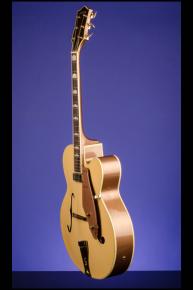An All Original, And Exceptionally Fine 1956 Gretsch Convertible/Sal Salvador
1956 Gretsch 6199 Convertible/Sal Salvador
This 17-inch-wide, 3 3/8 inches deep, jazz guitar with a Bamboo Yellow top and Copper Mist back and sides weighs just 6.50 lbs. Quad-bound pruce top with two large bound f-holes, laminated rock maple back (quad bound) and sides. Rock maple neck with a really fat nut width of just over 1 3/4 inches, a wonderful thick profile, a scale length of 25 1/2 inches and a bound rosewood fretboard with 21 original medium-thin frets and inlaid pearl hump-block position markers. Headstock with black-stained maple overlay and inlaid pearl Gretsch "T-roof" logo. Two-layer black over white plastic dome-shaped truss-rod cover with three screws. Individual Grover Imperial tuners with stairstep metal buttons. One 'suspended' DeArmond (Gretsch Dynasonic) pickup with an output of 9.74k. Gold-painted elongated Lucite pickguard with Gretsch "T-roof" logo in black (the pickguard covers most of the treble f-hole). Two controls (one volume, one tone) mounted on pickguard. The two potentiometers are stamped "137 549" (CTS, December 1955). Rosewood bridge with pre-set compensating saddle on height-adjustable rosewood base. Separate "G-hole flat" tailpiece secured to end of body by three screws. All hardware gold-plated. This guitar is in exceptionally fine (9.00) condition. There is some light finish checking on the body and a few small and insignificant surface chips. There is some light finish loss/playing wear on the sides of the neck (mainly on the treble-side by the first seven frets). The original frets have been dressed and have plenty of life left. Overall this wonderful and all original 'Jazzbox' is in exceptionally fine (9.000 condition. Housed in the original Gretsch five-latch, shaped two-tone gray hardshell case with burgundy plush lining (8.75).
"As a happy medium between the true acoustic archtops like the Eldorados, Fleetwoods and Constellations and the electric Country Clubs...Gretsch showcased its $295 Model 6199 Convertible finished in Bamboo Yellow [Ivory Mist] spruce top and bronze metallic-hued Copper Mist back, sides and neck in 1955. The true f-hole, 17-inch-wide, 3 1/2-inch-deep archtop has a 25 1/2-inch scale that terminates on a compensated, rosewood bridge. The peghead is white-black-white-bound, overlaid in black-stained maple, then inlaid with a real mother-of-pearl "Gretsch" block letter logo. Gold-plated Grover Imperial tuners and a small, bullet-shaped truss rod cover complete the headstock motif. The rosewood fingerboard is inlaid with real pearl humped-block inlays and bound in multiple black and white plastic. A single gold-plated DeArmond pickup is suspended above the top although its large polepieces project through a hole in the spruce, by an attachment to the mammoth, gold-painted, Synchromatic-style, Lucite guardplate which covers almost all of the treble f-hole; tone and volume controls are also located on the 'guard and the control knobs are gold-plated, knurled strap buttons. The suspended DeArmond allows the top to vibrate freely and makes the guitar convertible -- able to be played electrically or acoustically. Convertibles are, infact, good-sounding acoustic archtops. The Model 6199 Convertible's revolutionary two-tone color scheme evokes comparisons to the spilt-level [sic] paint jobs on Plymouth Savoys or Ford Crown Victorias...In 1959 the two-tone Convertible gave way to the sunburst -- the only optional Convertible finish…" (Jay Scott, The Guitars of the Fred Gretsch Company, pp. 175-177).
The first year Model 6199 as it appeared in the 1955 Gretsch catalog: "Play it electric or play it acoustic and get top tone either way. That's because instead of being built-in, the Gretsch-Dynasonic pickup of this guitar is suspended clear of the top to allow full, free vibration. Full, arched 17" body with cutaway; Gretsch slim, fast playing neck. Close-grained choice spruce top; selected rock-maple body and neck. This is a showman's guitar, finished in smart modern style with lotus ivory top and copper mist body and neck. Other features include: Over-size Lucite guard plate mounting the adjustable magnet Gretsch-Dynasonic pickup and the control knobs (volume and tone); Grover 16-to-1 ratio individual, covered machines. Rosewood fingerboard with pearl position markers. Metal parts heavily gold plated" (Jay Scott, The Guitars of the Fred Gretsch Company, p. 176).
"As the number of models in the Gretsch electric guitar line increased and the profile of the company was being raised by glossy new brochures and popular endorsers, it was decided to employ a quality-control person to ensure that what was actually coming out of the factory was equal to all this fresh attention. The new man to join the guitar team at the Brooklyn factory in 1956 was 24 year-old Dan Duffy, who'd been studying guitar with New York jazzman Sal Salvador. Salvador played a Gretsch Convertible model, introduced in 1955 and so-called because it combined electric and acoustic properties by mounting a pickup and associated controls on the pickguard, thus avoiding interference with the resonance of the archtop body. Salvador became so associated with the Convertible that toward the end of the 1950s Gretsch renamed it the Sal Salvador model" (Tony Bacon and Paul Day, The Gretsch Book, pp. 36-37).
"The Convertible, introduced in 1955, reflects the preference of jazz players for a guitar whose acoustic qualities are not compromised by the addition of electronics...The Convertible is the first Gretsch with a two-tone finish: lotus ivory top and copper mist back and sides. Sunburst was available by special order only" (George Gruhn and Walter Carter, Electric Guitars and Basses, p. 103).













